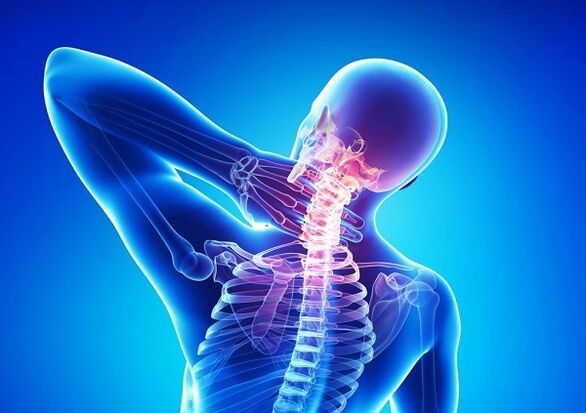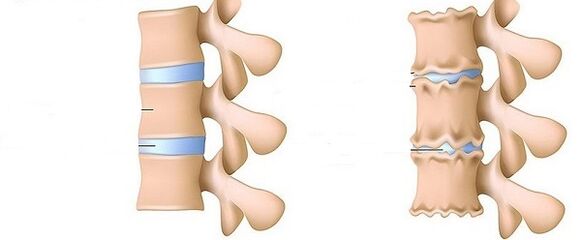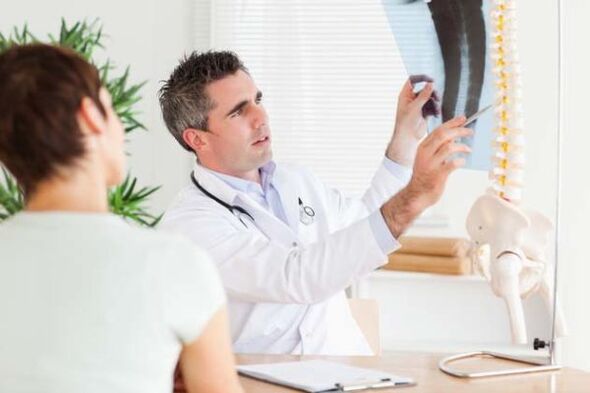Frequent aches and pains in your neck and head and spread to your arms and shoulders? Maybe you have cervical osteochondrosis, which should be treated as soon as possible? How to diagnose the disease and which doctor to consult? Also, how to provide first aid for osteochondrosis of the neck? Read about it in the article later.
Features of the disease
First of all, let's remember what kind of disease it is. Thus, osteochondrosis of the cervical vertebrae is a disease of the intervertebral discs of the cervical spine, which is the most mobile. In most cases, the lesion occurs at the level of the C5 - C7 vertebrae. The symptoms of the disease also depend on which vertebra is affected. More on that later.

Appearance reasons
To understand how to treat cervical osteochondrosis, you must first understand the causes of its appearance. First of all, let's say that this disease has become more widespread recently. The age risk zone is between 25 and 40 years. There can be many causes of the disease. The most common:
- work on a computer, as well as drive often and for a long time;
- inaction;
- salt accumulation in the cervical spine;
- impaired metabolism;
- poor nutrition;
- neck injuries;
- rheumatism;
- heredity;
- hormonal disruptions;
- severe hypothermia, etc.

Symptoms
The disease has a number of symptoms that can manifest themselves both individually and individually. It all depends on the affected area of the neck. So, to know how to treat cervical osteochondrosis, you need to learn what is affected and what the consequences may be. First, look at the general symptoms of cervical osteochondrosis.
- Pain. Pain syndrome is observed in the neck, back of the head, behind the shoulders. Pain can also be captured. This disease is responsible for 30% of all headaches. All this can compress the blood vessels with osteochondrosis. Thus, blood flow to the brain is reduced and severe headaches accompanied by rapid fatigue occur.
- Crunch. When turning and tilting the head, a characteristic strong crisis is felt.
- Matching. May be accompanied by a strong "lumbago" in the area of the shoulder blades. In addition, the neck itself may become numb, and there will be a noticeably unpleasant tingling sensation in the arm and leg area.
- Weakness and dizziness. In addition to all this, frequent fainting, drowsiness may appear, and general rapid fatigue may be observed.

If cervical spine osteochondrosis is treated at home, you still need to know how to pinpoint the lesion area. Here it is necessary to know what symptoms will occur if one or another nerve root near the vertebrae is affected. There are a total of 8 such processes in the cervical spine, and they are referred to as C1 - C8.
- With the defeat of C1 - a violation of sensitivity in the occipital region.
- C2 - Pains appear behind the head and crown.
- C3 - the disorder is accompanied by severe pain in the area where it occurs. Decreased neck sensitivity. The taste sensitivity of the tongue is impaired. Speech problems can arise.
- C4 - pain in the liver and heart. There is numbness and pain in the shoulders and between the shoulder blades.
- C5 - pain and tenderness in the upper shoulder.
- C6 - Very painful, including neck and shoulder blades. The pain spreads to the shoulder and spreads to the arm, reaching to the thumb.
- C7 - The symptoms are similar to C6, but the pain spreads to the back of the shoulder and the whole arm, affecting the fingers other than the little finger.
- Similar to C8 - C7. In addition, numbness and pain have already reached the little finger.
Species
Wondering if cervical spine osteochondrosis can be treated at home? Then you need to find out what stage of the disease. After all, only first-degree treatment can be done at home. In general, depending on the progression of the disease can be divided into 3 degrees.
- The first is that it goes on almost imperceptibly, and you don't even start thinking about how to deal with cervical osteochondrosis. However, at this stage it is possible to prevent the development of the disease. Symptoms include periodic numbness of the area between the neck and shoulder blades during prolonged sitting. Pain is rare, but may be accompanied by numbness and increased fatigue.
- The second type is disease progression. The intervertebral discs have shrunk and deformed, but can still be corrected. With any movement of the neck is felt a movement and pain, movements are limited. Urgent medical attention is required.
- The third type is an advanced stage of the disease. The integrity of the disks is already compromised here. Pain in the neck, head and shoulders is almost constant. Painful sensations are even transmitted to the hands and fingers. The appearance of a disease such as a hernia is possible. With more deformities and misalignment of the vertebrae, the fight against the disease can only continue with surgery.
Where can I turn for help?
So you have some symptoms of the disease and decided not to sit idle, to consult a specialist for help. The question is: "Which doctor treats cervical osteochondrosis? " It all depends on what stage of the disease you are in. Thus, the treatment of first-degree wounds can be performed by a therapeutic gymnastics specialist or a masseur. This includes alternative medicine, such as osteopathy.
Grade 2 osteochondrosis of the cervical spine already requires observation by a doctor in a clinic. Here, textbooks, physiotherapists or reflexology therapists can fight the wound. It is no longer necessary to consult a neurologist. Grade 3 cervical osteochondrosis requires more professional medical treatment. Here, a neurologist must first deal with the disease, because there are few nerve endings in the cervical spine. In an advanced condition, the surgeon treats cervical spine osteochondrosis with a neurologist.

Diagnostics
You should be examined before treating osteochondrosis of the neck. The attending physician will palpate the neck, perform a few manipulations, and question you. Be sure to schedule an x-ray of the cervical spine. In addition, a general blood test will be scheduled. They can be referred for an MRI or CT scan to better understand the disease.
How is the treatment performed?
First of all, let's answer the question "Is it possible to treat cervical osteochondrosis? "Yes, it is possible, but it is possible to completely fight the disease only in the early stages. But how to overcome cervical osteochondrosis? There are various treatments for this described below.
Medication
Medications are the most effective treatment for grade 2 and 3 cervical osteochondrosis. Complex treatment is carried out here. So, some medications should relieve the pain you are suffering from. Other drugs fight inflammation. Others - eliminates swelling, the fourth drug restores blood circulation and provides the sick area with food. All can be in tablet form and in the form of injections and injections. Ointments will be ineffective with cervical spine osteochondrosis.

The whole treatment of cervical osteochondrosis in women and men is divided into 3 stages.
- First, the medication must quickly relieve the pain, eliminate the swelling, and have an anti-inflammatory effect.
- In the second stage, each remedy should create a restorative healing effect.
- The third stage is restorative. This includes vitamins, therapeutic gymnastics and massage.
Since you were tortured with osteochondrosis and decided to go to the hospital, please do not treat yourself and follow all the instructions of your doctor.
Physiotherapy
Physiotherapy can answer how you can treat cervical spine osteochondrosis. The most commonly used methods are:
- magnetotherapy;
- electrotherapy;
- laser treatment;
- UFO;
- others in balneotherapy.
Surgical intervention
Sometimes only a surgeon can answer how to get rid of cervical osteochondrosis. The operation is planned after consultation with a neurologist. Here, the surgeon must work as hard as possible to reverse the osteochondrosis that beats you. Prepare for a long recovery course after surgery.
ethnology
What will folk medicine say to all this? There are enough methods and tools to treat such a disease. However, keep in mind that you are acting at your own peril and risk, so you are solely responsible for the consequences. So, how to deal with osteochondrosis using folk remedies.
- The first method is compresses for cervical osteochondrosis derived from Indian onion leaves. To do this, you need to take a leaf of the plant, rub the affected areas, and then apply the remnants as a compress overnight. The healing effect should be observed the next morning.
- Another compress for the night is made from cottage cheese sprinkled with vinegar. The treatment is done for several consecutive nights until the effect is visible.
- Horseradish leaves are used in a similar way. We take a freshly plucked leaf of a plant, rinse it in hot water and apply it to the wound at night after wrapping it with something warm before.
- How to treat cervical osteochondrosis with a shovel? And everything here is quite simple. The truth is that we do not need all the shovels, but only a part called the handle, which is more than a meter long. To make a miracle medicine from it, you have to take it with both hands and wrap it around your neck. In addition, we massage the affected areas with up and down movements. The procedure should be performed at least several times a week.

Contraindications to treatment
Sometimes a difficult question arises: "What can and cannot you do with cervical osteochondrosis? " It turns out that not all medical procedures always have a therapeutic effect. Sometimes they can be very harmful to the patient. Therefore, it is worth treatment only on the advice of the attending physician. Thus, this includes the following procedures used in the treatment of osteochondrosis:
- acupuncture;
- therapeutic gymnastics or exercise therapy;
- massage.
Acupuncture for osteochondrosis is contraindicated if you are 75 or older, as well as for pregnant women. The rest of the contraindications for this procedure are the same as for massage. These include:
- Blood diseases.
- All kinds of bleeding.
- Increased mental excitement.
- Any difficulty in breathing.
- Digestive system problems.
There are also contraindications to sports therapy or physical therapy, which is a disease such as osteochondrosis. The most common are unhealed injuries, severe bruises and hematomas. Contraindications here include:
- acute exacerbation of the disease;
- weak heart;
- manifestations of tachycardia or arrhythmia;
- severe diabetes;
- bleeding tendency;
- infectious wounds;
- there are diseases associated with the vestibular apparatus;
- vision problems;
- neurological symptoms leading to loss of coordination.
How can first aid be provided?
If osteochondrosis has surprised you at home, first aid will be as follows:
- Take your painkiller in the normal dose.
- See your doctor at home, as you may need more radical methods and other medications.
- Try not to make sudden movements with your head or body.
- Take the covers off the bed and lie down with a small pillow under your head. If the mattress is soft enough, lie on a bench or on the floor.
- Try to relax and think of something good to make the painkiller work faster. If the doctor is late, do not sleep in one position for a long time.
















